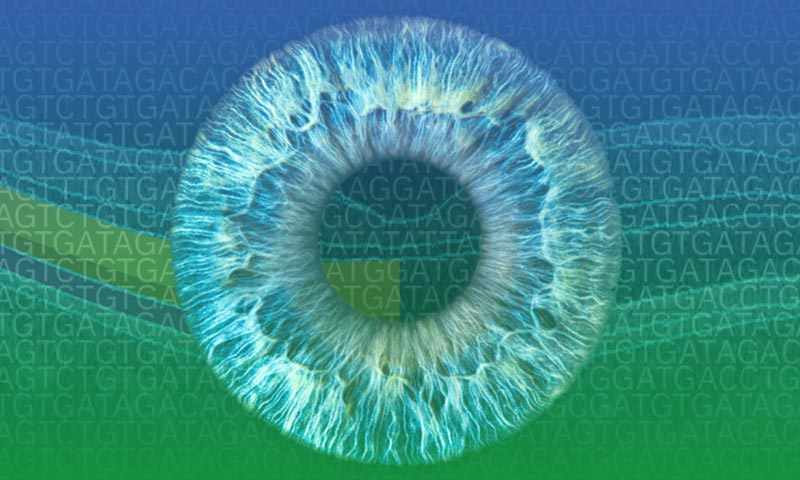
New Insights Into Rare Eye Disorders from Large-Scale Study

Large-scale data enables new insights into rare eye disorders
Credit: Karen Arnott/EMBL-EBI
EMBL-EBI researchers use UK Biobank data to uncover new information about rare diseases of the eye.
Researchers have analysed image and genomic data from the UK Biobank to find insights into rare diseases of the human eye. These include retinal dystrophies – a group of inherited disorders affecting the retina – which are also the leading cause of blindness certification in working-age adults.
The retina is found at the back of the eye. It’s a layered tissue that receives light and converts it into a signal that can be interpreted by the brain. Each retinal layer comprises different cell types that play a unique role in this light conversion process.
For this study published in the journal PLOS Genetics, the researchers focused on photoreceptor cells (PRCs), which are light-detecting cells found in the retina. These cells can be non-invasively imaged using optical coherence tomography (OCT), a service now commonly offered in many opticians. Using OCT image data and genomic data stored in the UK Biobank, researchers were able to generate the largest genome-wide association study of PRCs.
Rare retinal dystrophies
Rare diseases of the retina are frequently caused by inherited mutations in genes expressed by PRCs. These mutations cause the retina to function incorrectly, resulting in sight impairment or even blindness. Although these individual diseases are rare, together they are the leading cause of blindness in working-age adults.
“We had access to coupled images and genotype data at a scale that had not been seen in a study of this kind,” said Hannah Currant, former PhD student at EMBL’s European Bioinformatics Institute (EMBL-EBI) and Postdoctoral Fellow at the Novo Nordisk Foundation Center for Protein Research (CPR) University of Copenhagen. “Access to this enormous amount of data was critical to the study and enabled us to identify genetic links to rare retinal dystrophies. This work has identified new avenues for research and generated new questions about rare retinal dystrophies.”
Linking genotype and phenotype
OCT produces high-resolution images that can be used to identify the different layers and structures within the retina. These images are commonly used in the clinic to aid the diagnosis of eye disorders. For this study, the researchers used OCT images and the corresponding genomic and medical information of over 30,000 participants stored in the UK Biobank.
“The UK Biobank is a rich, invaluable resource that has enormous potential to enable genomic medicine,” said Ewan Birney, Deputy Director General of the European Molecular Biology Laboratory (EMBL). “There is so much potential just waiting to be released from the data stored there, which lets us both understand human biology and how and when it goes wrong in disease.”
Driving genomic medicine
The researchers conducted genome-wide association studies (GWAS) on the UK Biobank data to look for genetic variations linked to differences in the thickness of the PRC layers. This led them to identify genomic variations associated with the thickness of one or more of the PRC layers, including those with prior associations with known eye diseases. The newly identified genomic associations are stored and can be openly accessed through the GWAS Catalog.
Some of these genetic variants were known to be linked to eye diseases, but surprisingly, a number of relatively common genetic variants were near genes known to cause rare genetic eye diseases when disrupted. In one case, the researchers were able to explore how combinations of common variants near genes known to be involved in rare eye diseases change the structure of the retina. This gives more confidence when looking into specific rare disease collections to see how these specific common variants might impact disease.
“Systematic bioinformatic analysis of large-scale participant data cohorts is driving the future of genomic medicine,” said Omar Mahroo, Professor of Retinal Neuroscience at University College London and Consultant Ophthalmologist at Moorfields Eye Hospital. “Having access to these data and being able to make these connections between disease phenotypes and genetic variation will open many new opportunities for modern disease diagnosis and therapeutics.”
Developing a molecular understanding of how the human ecosystem – the social, physical and biological factors we are exposed to throughout our lives – interacts with our genetic makeup to influence our health is a priority for EMBL. Find out more about how researchers across EMBL will leverage the unprecedented depth and breadth of emerging human cohort data to aid our understanding of human diseases.
Journal: PLoS Genetics
DOI: 10.1371/journal.pgen.1010587
Method of Research: Data/statistical analysis
Subject of Research: People
Article Title: Sub-cellular level resolution of common genetic variation in the photoreceptor layer identifies continuum between rare disease and common variation
Article Publication Date: 9-Mar-2023
Media Contact
Victoria Hatch
European Molecular Biology Laboratory
vhatch@ebi.ac.uk
Cell: 07411495115















